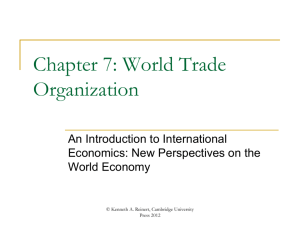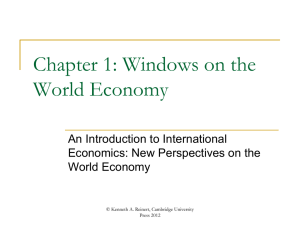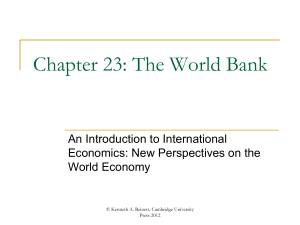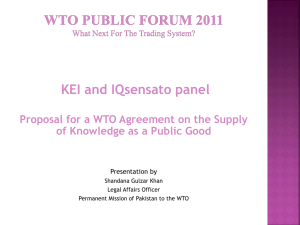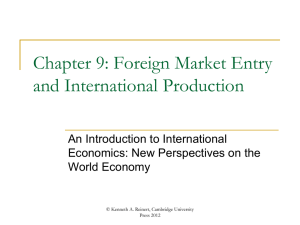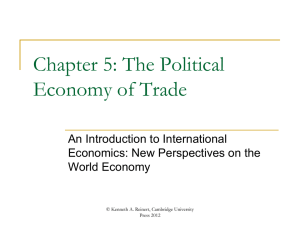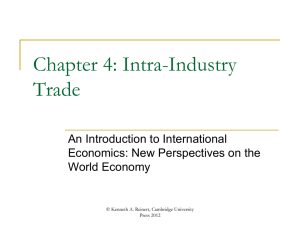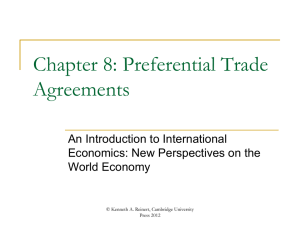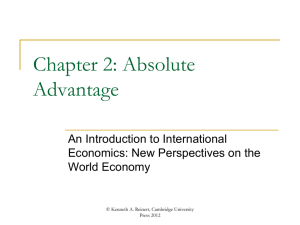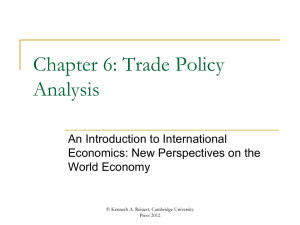Chapter 7 - An Introduction to International Economics
advertisement
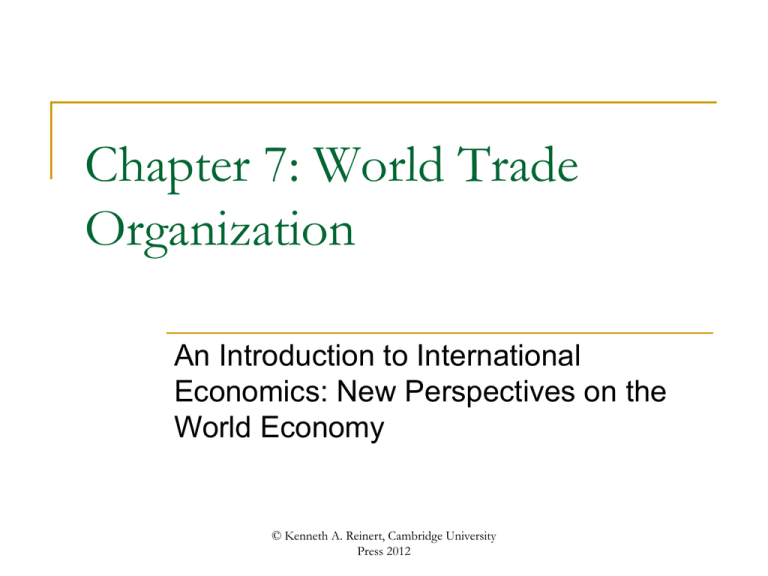
Chapter 7: World Trade Organization An Introduction to International Economics: New Perspectives on the World Economy © Kenneth A. Reinert, Cambridge University Press 2012 Introduction Chapter covers key aspects of the World Trade Organization (WTO) Covers the General Agreement on Tariffs and Trade (GATT) and trade in goods Addresses trade in services and intellectual property Discusses dispute settlement, the environment and the Doha Round © Kenneth A. Reinert, Cambridge University Press 2012 The General Agreement on Tariffs and Trade In 1944, the United States and Britain held a conference (Bretton Woods) that established: International Bank for Reconstruction and Development (World Bank) International Monetary Fund In 1945, the United States attempted to launch idea of an International Trade Organization (ITO) London—twenty-three founding members were present and signed General Agreement on Tariffs and Trade (GATT) In 1948 ITO charter was agreed to at a United Nations Conference In 1950 US announced it would not seek US Congressional ratification of Havana Charter, effectively terminating ITO plan Vehicle for post-war trade negotiations became GATT © Kenneth A. Reinert, Cambridge University Press 2012 The General Agreement on Tariffs and Trade Between 1946 and 1994, the GATT provided a framework multilateral trade negotiations Rounds reduced tariffs among member countries in many (but not all) sectors Weighted average tariff on manufactured products imposed by industrial countries fell from 20% to 5% However GATT suffered from what some defects that limited its effectiveness A number of these defects were addressed in the Marrakesh Agreement at the end of the Uruguay Round of multilateral trade negotiations © Kenneth A. Reinert, Cambridge University Press 2012 Non-Discrimination Principle Non-discrimination has two elements Most-favored nation (MFN) applying to border measures Each member must grant treatment to all other members as favorable as it extend to any individual member country National Treatment (NT) applying to behind-theborder measures Foreign goods within a country should be treated no less favorably than domestic good with regard to tax policies and other regulations © Kenneth A. Reinert, Cambridge University Press 2012 Figure 7.1: Non-Discrimination Principle © Kenneth A. Reinert, Cambridge University Press 2012 General Prohibition of Quotas A second important GATT principle General prohibition of quotas or quantitative restrictions on trade Reflects a longstanding view that price distortions (tariffs) are preferred to quantity distortions in international markets Quantitative restrictions were one of the most significant impediments to trade prior to GATT Exceptions are allowed © Kenneth A. Reinert, Cambridge University Press 2012 Tariff Bindings and Fair Trade Tariffs are bound at an agreed-upon level often above applied levels Levels may not be increased in the future Applied rates below bound rates may be increased GATT introduced stipulations with regard to subsidies, countervailing duties, and antidumping duties Use of subsidies is not supposed to harm trading interests of other members If subsidies cause “material injury” or “threat thereof” to a domestic industry of another country, that country can apply countervailing duties or tariffs on its imports of the product from the subsidizing country “Dumped goods are defined as exports sold below those charged by the exporter in its domestic market It dumped goods cause “material injury” or “threat thereof” to a domestic industry of another country, that country can apply anti-dumping duties or tariffs on its imports of the product from the dumping country © Kenneth A. Reinert, Cambridge University Press 2012 Table 7.1: GATT/WTO Rounds of Multilateral Trade Negotiations Name of Round Years Number of Countries Auspices Geneva 1947 23 GATT Annecy 1949 29 GATT Torquay 1950-1951 32 GATT Geneva 1955-1956 33 GATT Dillon 1960-1961 39 GATT Kennedy 1963-1967 74 GATT Tokyo 1973-1979 99 GATT Uruguay 1986-1994 117 GATT Doha 2001- Over 150 GATT Source: WTO © Kenneth A. Reinert, Cambridge University Press 2012 The World Trade Organization The Marrakesh Agreement created the WTO and included the WTO “tripod” General Agreement on Tariffs and Trade (GATT 94) on trade in goods General Agreement on Trade in Services (GATS) Agreement on Trade-Related Aspects of Intellectual Property Rights (TRIPS) Included a WTO charter Established WTO as a legal international organization Stipulated that “WTO shall provide the common institutional framework for the conduct of trade relations among its members” Defined the functions of WTO © Kenneth A. Reinert, Cambridge University Press 2012 Table 7.2: Administrative Structure of the WTO Body Composition Ministerial Conference Representatives of all members General Council Representatives of all members Council for Trade in Goods Representatives of all members Council for Trade in Services Representative of all members Council for Trade-Related Aspects of Intellectual Property Rights Representatives of all members Dispute Settlement Body Representatives of all members Dispute Settlement Panels Three or five well-qualified governmental and/or nongovernmental individuals Appellate Body Seven persons, three of whom serve on any once case Secretariat Director General and staff © Kenneth A. Reinert, Cambridge University Press 2012 GATT: Agreement on Agriculture Agreement on Agriculture addressed three issues Market access Replaced quotas with a system of bound tariffs (tariffication) and tariff-reduction commitments Domestic support Distinction was made between Export subsidies “Green box” measures—are exempt from any reduction commitments “Amber box” measures—are not exempt Use was not eliminated but limited to specified situations Represented a change in rules with little actual liberalization © Kenneth A. Reinert, Cambridge University Press 2012 Trade in Services General Agreement on Trade in Services (GATS)— significant outcome of Uruguay Round Represented first time services were brought into a multilateral trade agreement Negotiations were difficult due to fact that trade in services is less tangible than trade in goods Defined trade in services as occurring in one of four modes Mode 1: Mode 2: Mode 3: Mode 4: Cross-border trade Movement of consumers Foreign direct investment or FDI Movement of natural persons © Kenneth A. Reinert, Cambridge University Press 2012 Trade in Services Cross-border trade Mode of supply that does not require physical movement of producers or consumers Movement of consumers Consumer travels to the country of producer For example, tourism services Foreign direct investment Services that require a commercial presence by producers in country of the consumers For example, Indian firms provide medical transcription services to US hospitals via satellite technology For example, financial services Temporary movement of natural persons Non-commercial presence by producers For example, consulting, construction, and instructional services © Kenneth A. Reinert, Cambridge University Press 2012 GATS Protocols Second GATS Protocol: Revised Schedules of Commitments on Financial Services, 1995 Third GATS Protocol: Schedules of Specific Commitments Relating to Movement of Natural Persons, 1995 Fourth GATS Protocol: Schedules of Specific Commitments Concerning Basic Telecommunications, 1997 Fifth GATS Protocol: Schedules of Specific Commitments and Lists of Exemptions from Article II Concerning Financial Services, 1998 © Kenneth A. Reinert, Cambridge University Press 2012 Intellectual Property An asset in the form of rights conferred upon a product of invention or creation by a country’s legal system Agreement on Trade-Related Aspects of Intellectual Property Rights Most contentious aspect of Marrakesh Agreement Defined intellectual property as belonging to one of six categories Copyrights Trademarks Geographical indications Industrial designs Patents Layout designs of integrated circuits Applied the principle of nondiscrimination to intellectual property © Kenneth A. Reinert, Cambridge University Press 2012 TRIPS Agreement Sets out obligations for members Copyrights Trademarks Members must protect “independently created industrial designs that are new or original” Patents Members must provide legal means to prevent false use of geographical indications Industrial designs Goods and services are to be protected for a term of no less than seven years Provisions for the registration of trademarks must be made and are renewable indefinitely Geographical indications Members must comply with 1971 Berne Convention on copyrights Exceptions exist and include protection of public order, human, animal, and plant life Layout designs of integrated circuits Distribution of protected layout designs is forbidden © Kenneth A. Reinert, Cambridge University Press 2012 TRIPS Agreement Citizens and firms in developed countries own most of the world’s IP Developing countries currently often have less IP protection than developed countries Raises cost of many goods and services to developing countries Especially in the case of patents Represents a transfer from developing country consumers to developed country producers Issues have also been raised about the impact of new pharmaceutical patents on access to medicines © Kenneth A. Reinert, Cambridge University Press 2012 Dispute Settlement Marrakesh Agreement included an Understanding on Rules and Procedures Governing the Settlement of Disputes Original GATT was unclear about resolution of disputes—Marrakesh Agreement attempted to clarify dispute settlement procedures WTO includes councils on trade in goods and services as well as a council on TRIPs Should help minimize occurrence of disputes © Kenneth A. Reinert, Cambridge University Press 2012 Figure 7.2: Dispute Settlement © Kenneth A. Reinert, Cambridge University Press 2012 Dispute Settlement If the consultation process fails to settle a dispute within 60 days, the complaining member may request the establishment of a panel Composed of three or five “well-qualified governmental or non-governmental individuals” Function is to assist DSB in dispute settlement process Consults the parties involved and provides DSB with a written report of its findings DSB has 60 days to adopt report by consensus unless a party to dispute decides to appeal The appeal of a panel report is referred to an appellate body Reviews the appeal and submits its report to the DSB Any DSB member can effectively insist on the adoption of the appellate body report © Kenneth A. Reinert, Cambridge University Press 2012 Dispute Settlement Dispute settlement procedure applies to all aspects of the Marrakesh Agreement Improves procedures of old GATT Effectiveness of procedures depends on members’ commitment to it A country has option of ignoring outcome of the dispute settlement process Complaining member has right to impose retaliatory tariffs on a volume of imports from the other country determined by the DSB © Kenneth A. Reinert, Cambridge University Press 2012 The Environment In 1991, the GATT reactivated a long-dormant Working Group on Environmental Measures and International Trade (EMIT) GATT dispute resolution panel issued its controversial opinion in the now-famous tuna-dolphin case Ruled against US law banning imports of Mexican tuna that involved dolphin-unsafe fishing practices Argued import ban violated general prohibition against quotas and United States had not attempted to negotiate cooperative agreements on dolphin-safe tuna fishing US environmental community reacted strongly against the GATT panel ruling, casting the GATT as anti-environment © Kenneth A. Reinert, Cambridge University Press 2012 Committee on Trade and the Environment EMIT was replaced by Committee on Trade and the Environment Most developing country members of WTO have taken a dim view of the work of CTE Fear the possibility of further protection against their exports in the form of “green protection” Often view environmental matters having no place in the WTO Many trade economists support the developing-country view that environmental issues represent an “intrusion” into WTO trade agenda They do, however, support the use of multilateral environmental agreements and perhaps even an World Environmental Organization © Kenneth A. Reinert, Cambridge University Press 2012 Committee on Trade and the Environment In 1999, WTO formally took up trade and environment issue Report argued increased trade can have both positive and negative impacts on the environment Emphasized trade-driven growth cannot always be counted upon to deliver improvements in environmental quality through increased incomes Consequently, these higher incomes must be “translated into higher environmental quality” through mechanism of international cooperation Also emphasized that government subsidies to polluting and resource-depleting sectors can exacerbate the environmental consequences of trade © Kenneth A. Reinert, Cambridge University Press 2012 The Doha Round Launched in Doha, Qatar in 2001 Progress has been very uneven, with a noted failure at the 2003 Cancun Ministerial Meeting July 2004, October 2005 and July 2008 negotiations made some progress on contentious agricultural issues A “final countdown” to conclude the Round by the end of 2011 was missed Significant issues remain in agriculture and in “nonagricultural market access” (NAMA) © Kenneth A. Reinert, Cambridge University Press 2012 Tariff Formulas Tariff formulas can be used to determine tariff reductions in rounds of trade negotiations Proportional t1 at0 0 a 1 Swiss formula bt0 t1 b t0 0 b 100 © Kenneth A. Reinert, Cambridge University Press 2012 Figure 7.3: Tariff Formulas © Kenneth A. Reinert, Cambridge University Press 2012 Figure 7.4: Members and Years to Conclude GATT/WTO Rounds © Kenneth A. Reinert, Cambridge University Press 2012
